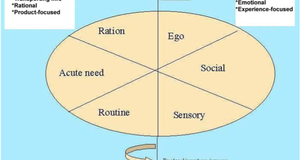From Elon Journal of Undergraduate Research in Communications VOL. 5 NO. 1The Efficacy of Guerrilla Advertising on Public Health IssuesConclusionsDriven solely to encourage the well-being of a society or individual, the public health industry is beginning to use guerrilla advertising, which can be extremely effective and without the same monetary risks that other profit-driven industries face. Public health initiatives do not rely as heavily on profits or sales or even brand perception as commercial counterparts, but rather they rely on the resonance of messages, which are vital in disseminating public health information, encouraging participation in initiatives, and discouraging dangerous behavior, whether positive, negative, or neutral. For this study, the RIA scale was developed to provide a starting point for assessing the efficacy of guerrilla advertising in public health. Based on other important research on the resonance of a message, the author developed three subscales (fear appeal, sensory involvement, and environmental circumstances) in the RIA scale. Since this RIA scale fills the void that exists in evaluating the application of a non-traditional advertising strategy in non-commercial industries, it is the author’s hope that this scale could be tested, evaluated, criticized and improved upon to further this field of study. Limitations and implications for future researchThis study has a few limitations. The selected advertisements were analyzed as static images out of context. Advertisements in the real environments might have brought different emotional experience to their viewers. The RIA Scale is still a crude measurement in assessing the efficacy of guerrilla advertising for public health issues, so it could have been more meaningful if the scale’s validity and reliability had been tested. Further studies can be done with different kinds of guerrilla advertisements. The chosen advertisements involve clear public health issues that have distinct values and consequences. For example, smoking can cause lung cancer, sun exposure can cause skin cancer, and drunk driving can cause collisions. Advertisements on issues that are not as clear and are more divisive in their benefits and consequences, like breast-feeding, vaccinations or nutrition, could lead to different kinds of results. These issues may not trigger the same behavioral change through fear appeal that an anti drunk-driving initiative would arouse. Another study can be done to compare people’s intended behavior or their opinions before and after being exposed to the advertisement. Additionally, an advertisement like “The Smoker’s Lung ” can recommend that viewers visit a website and sign a pledge to stop smoking, which can generate a quantifiable measurement of the advertisement’s resonance and impact and the future behaviors of its audience. AcknowledgementsThis author is thankful to Dr. David Copeland at Elon University for his supervision and advice, without which the article could not be published. The author also appreciates numerous reviewers who have helped revise this article. ReferencesAbdul-Razzaq, Serin, Lucie Ozanne, and David Fortin. “Cutting Through the Clutter? A Field Experiment Measuring Behavioral Responses to an Ambient Form of Advertising.” Proceedings of Australian and New Zealand Marketing Academy Conference. 2009. Web. 15 Oct. 2013. Andreasen, Alan R. “Social marketing: its definition and domain.” Journal of Public Policy & Marketing (1994): 108-114. Web. 22 Oct. 2013. Arello, JoAnn. “MADD: ‘Crash’.” Adweek. 2011. Web. 10 Oct. 2013. Ay, Canan, Pinar Aytekin, and Sinan Nardali. “Guerrilla marketing communication tools and ethical problems in guerilla advertising.” American Journal of Economics and Business Administration 2.3 (2010): 280. Web. 11 Oct. 2013. Belić, Sandra, and Emelie Jönsson. “Guerrilla marketing: and its effects on consumer behavior.” Diss. Kristianstad University, 2012. Web. 11 Oct. 2013. Bigat, Ekrem Cetin. “Guerrilla advertisement and marketing.” Procedia-Social and Behavioral Sciences 51 (2012): 1022-1029. Web. 14 Oct. 2013. Boer, Henk, and Erwin R. Seydel. “Protection motivation theory.” (1996): 95-120. Brown, Millward. “Should My Advertising Stimulate an Emotional Response?.” 2009. Web. 16 Oct. 2013. Cooch Creative. “SunSmart Cancer Council Western Australia: ‘Cut Out’.” Ads of the World. 2011. Web. 11 Oct. 2013. Grier, Sonya, and Carol A. Bryant. “Social marketing in public health.” Annu. Rev. Public Health 26 (2005): 319-339. Web. 15 Oct. 2013. Hutter, Katharina, and Stefan Hoffmann. “Guerrilla marketing. The nature of the concept and propositions for further research.” Asian Journal of Marketing 5.2 (2011): 39-54. Jurca, Maria Alina. “The forms of unconventional advertising–A theoretical approach.” Management & Marketing-Craiova 2 (2010): 323-333. Levinson, Jay. ”Guerilla Marketing: Easy and Inexpensive Strategies for Making Big Profits from Your Small Business.” 4th ed. New York: Houghton Mifflin, 2007. Print. Lindstrom, Martin. “Broad sensory branding.” Journal of Product & Brand Management 14.2 (2005): 84-87. Lukic, Dina. “Emotional Appeals in Social Marketing.” 2009.Web. 14 Oct. 2013. Serviceplan. “AOK- ‘The Smoker’s Lung’.” Ads of the World. 2006. Web. 10 Oct. 2013. Shams, Ladan, and Aaron R. Seitz. “Benefits of multisensory learning.” Trends in cognitive sciences 12.11 (2008): 411-417. Taxi Canada. “McCain Smooth-eez: ‘Blender’.” Ads of the World. 2007. Web. 17 Oct. 2013. “What is Public Health.” What is Public Health. Association of Schools of Public Health. Web. 11 Nov. 2013. Williams, Kaylene C. “Fear appeal theory.” Research in Business and Economics Journal 5 (2012): 1-21. AppendixAdvertisement 1: “The Smoker’s Lung” Body Copy above glass lung: Website URL for The AOK (Germany’s largest health insurance company) Advertisement 2: “Cut Out” Headline: “Cutting your sun exposure is easier than cutting out a skin cancer” Body Copy: “Free 30+ sunscreen. There is nothing healthy about a tan. Protect yourself 5 ways from skin cancer.” Advertisement 3: “Crash” MADD: Mothers Against Drunk Driving Headline: Don’t Drink and Drive Suggested Reading from Inquiries Journal
Inquiries Journal provides undergraduate and graduate students around the world a platform for the wide dissemination of academic work over a range of core disciplines. Representing the work of students from hundreds of institutions around the globe, Inquiries Journal's large database of academic articles is completely free. Learn more | Blog | Submit Latest in Business & Communications |





























